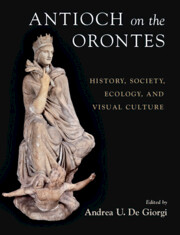Book contents
- Antioch on the Orontes
- Antioch on the Orontes
- Copyright page
- Dedication
- Contents
- Plates
- Figures
- Tables
- Contributors
- Abbreviations
- Antioch on the Orontes
- Part I Beginnings
- Part II The Making of a Capital
- Chapter 8 Antioch as a Provincial Capital
- Chapter 9 Building Programs and Natural Disasters
- Chapter 10 The City Walls of Antioch
- Chapter 11 Powerful Springs and Dangerous Torrents on Unsafe Ground
- Chapter 12 Housing in Daphne
- Chapter 13 The Antioch Mosaics
- Chapter 14 Coinage of and in Antioch in the Late Antique and Early Byzantine Periods
- Part III The People of Antioch
- Part IV Religion
- Part V Crises and Resilience
- Index
- Plate Section
- References
Chapter 14 - Coinage of and in Antioch in the Late Antique and Early Byzantine Periods
from Part II - The Making of a Capital
Published online by Cambridge University Press: 06 June 2024
- Antioch on the Orontes
- Antioch on the Orontes
- Copyright page
- Dedication
- Contents
- Plates
- Figures
- Tables
- Contributors
- Abbreviations
- Antioch on the Orontes
- Part I Beginnings
- Part II The Making of a Capital
- Chapter 8 Antioch as a Provincial Capital
- Chapter 9 Building Programs and Natural Disasters
- Chapter 10 The City Walls of Antioch
- Chapter 11 Powerful Springs and Dangerous Torrents on Unsafe Ground
- Chapter 12 Housing in Daphne
- Chapter 13 The Antioch Mosaics
- Chapter 14 Coinage of and in Antioch in the Late Antique and Early Byzantine Periods
- Part III The People of Antioch
- Part IV Religion
- Part V Crises and Resilience
- Index
- Plate Section
- References
Summary
In its capacity as the principal city on the east coast of the Mediterranean, Antioch was an important center of both minting and coin circulation during the fourth through seventh centuries. Moreover, as the launching site for military expeditions against the Persians and, eventually, the Arabs, Antioch served as the temporary capital for emperors and other military leaders stationed there and as a distribution point for soldiers’ salaries and other monetary activities.
Keywords
- Type
- Chapter
- Information
- Antioch on the OrontesHistory, Society, Ecology, and Visual Culture, pp. 225 - 244Publisher: Cambridge University PressPrint publication year: 2024

